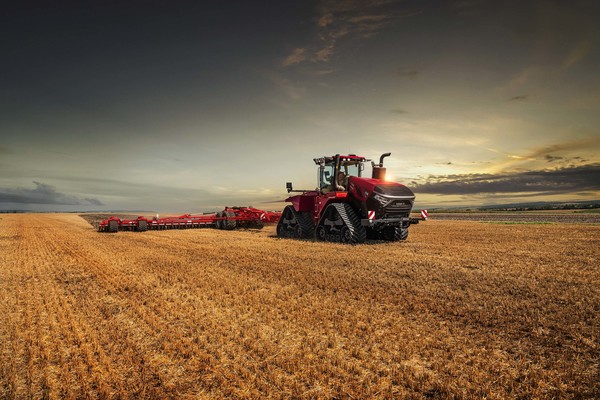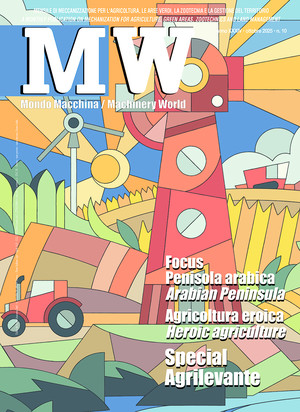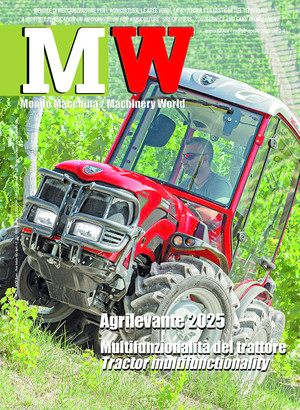
High-powered rubber-tracked tractors
Power, pulling capacity, and precision: large rubber-tracked tractors represent the most advanced evolution in agricultural mechanization today. Designed to tackle difficult terrain and demanding tasks, they guarantee high performance and excellent soil protection
In recent decades, agriculture has undergone a radical transformation, linked on the one hand to the evolution of mechanical, electronic, and information technologies, and on the other to the growing need to optimize working times, reduce costs, and increase the environmental sustainability of agricultural processes. This context has seen the development of high-powered tractors with rubber tracks, an intermediate solution between traditional wheeled models and those equipped with conventional tracks, with chains and steel plates. These vehicles were introduced to the market in the late 1980s to combine very high pulling power and reduced soil compaction (typical features of conventional tracked tractors) with the versatility, comfort, and high road transfer speed of wheeled tractors. The first models of tracked vehicles with rubber treads were manufactured in North America for use in areas characterized by large cultivated areas and the consequent need for very powerful and reliable machines capable of performing all tasks efficiently in any soil conditions. Today, these machines are also of interest in Italy, particularly for large farms and especially for agricultural machinery companies that carry out deep tillage in heavy soils at risk of compaction and/or with poor traction. It is no coincidence that rubber-tracked tractors are widely used in rice fields, reclaimed areas, and large arable areas in central and northern Italy.
Technical description. Rubber-tracked tractors are motor vehicles that use a continuous track system instead of pneumatic wheels. a track system consisting of a continuous belt, internally reinforced with thin steel cables with high mechanical resistance, and externally equipped with a tread made of highly durable rubber compound, featuring ribbing for traction. The propulsion system can be two- or four-track. In the former case, the tractor has two large tracks on each side of the machine, instead of rear wheels, which remain drive wheels, while the front wheels act as track tensioners. Steering is similar to that of conventional tracked tractors.
In the second case, an independent triangular track replaces each wheel of the tractor. The machine thus equipped takes on the typical configuration of articulated vehicles and is able to offer a very large support surface, optimal weight distribution, and very high traction force.
The rubber tracks are mounted on sturdy suspended frames, which include load-bearing rollers, upper rollers, idler wheels, and toothed drive wheels. Since the rollers and wheels are also rubber-coated, this system absorbs shocks and vibrations, increasing the durability of the tracks and improving operator comfort.
The engines of large rubber-tracked tractors develop power ratings ranging from 230 to over 670 kW, with a torque reserve of around 40%. They are therefore the most powerful tractors currently available on the market, with 6-cylinder engines and a displacement of over 16,000 cm³.The transmission can be full powershift or continuously variable, while the maximum road speed is 40 km/h.
Particularly noteworthy is the hydraulic system, which can include both front and rear distributors (up to 8 double-acting outlets) with a total oil flow rate of over 400 l/min. The power take-off is typically available at 1000 rpm and 1000 ECO.
In the more powerful models, the mass can reach 32,000 kg with full ballast. The rear lift, on the other hand, is designed for a maximum load of approximately 15,000 kg: this is a relatively modest value compared to the size of the tractor, which highlights the main purpose of these machines, namely coupling with large towed implements rather than mounted or semi-mounted implements. This is confirmed by the mass/power ratio of 60 kg/kW, which is intermediate between conventional wheeled and tracked tractors. In addition, the rubber tracks, together with a more efficient distribution of loads on the ground, allow for very high pulling capacity, thanks to the very large contact surface with the ground. At the same time, rubber tracks result in a more uniform distribution of the tractor's weight, with a consequent reduction in the pressure exerted on the ground. This limits compaction, helping to maintain adequate soil porosity, which is essential for ensuring an adequate water and gas balance within the soil profile, to the benefit of soil fertility.
Unlike traditional metal tracks, rubber tracks offer greater versatility: they allow for easier travel on roads, reducing vibrations, noise, and wear on the road surface. This translates not only into less impact on road infrastructure, but also into smoother and more comfortable driving, with transfer speeds comparable to those of wheeled tractors.
Finally, the aspect of operator comfort should not be overlooked. The cabs of the latest generation of tracked tractors are spacious, ergonomic, and equipped with modern suspension systems. The shock-absorbing action of the tracks, combined with that of the suspension, significantly reduces vibrations and jolts, ensuring a comfortable and safe working environment even on the longest and most demanding working days.
Although they offer numerous advantages, rubber-tracked tractors have some limitations that affect their use, making them not always suitable for all operating situations. From an economic point of view, the purchase cost of a rubber-tracked tractor is generally higher than that of a wheeled model of equal power. Added to this are maintenance costs, particularly those related to the periodic replacement of tracks, which are technically complex components subject to progressive wear. Wear is one of the main critical aspects. Although reinforced and made with high-performance compounds, rubber tracks tend to deteriorate over time, especially when used for long road transfers, on rough terrain, or in particularly heavy-duty applications. Replacing them is often very costly and requires a significant amount of time. A further limitation is related to maneuverability. Given the size of these machines, the steering system can be less responsive than that of wheeled tractors, making manoeuvring in confined spaces or on farms with small, irregularly shaped plots more difficult. Finally, under certain operating conditions, such as during light work or on land with good bearing capacity, tracked tractors can be less energy efficient. In such situations, their greater rolling resistance results in proportionally higher fuel consumption compared to wheeled tractors in the same category.
Half-tracked models. Half-tracked tractors (also known as half-tracked tractors) deserve a special mention. These are agricultural machines in which the rear axle is equipped with rubber tracks instead of wheels, while the front axle has normal tires. In practice, they are a cross between a wheeled tractor and a tracked tractor.
With this configuration, the rear tracks increase the contact surface with the ground, reducing ground pressure compared to tires, while the large diameter front wheels ensure that the machine retains good maneuverability. With a wide steering angle, the tractor can easily turn at the end of the field without leaving the typical tracks caused by the tracks.
Large rubber-tracked tractors are one of the most significant innovations in contemporary agricultural engineering, the result of a successful balance between pulling power, soil protection, and operational versatility. These vehicles have significantly changed the way large farms and contractors work, especially in areas characterized by difficult terrain and extensive cultivation that require high power. However, in Italy, their use is still limited by high purchase and maintenance costs, as well as some critical issues related to track durability and maneuverability. Technological research is therefore focusing on reducing costs and integrating with precision electronic systems (in particular with semi-automatic steering systems and ISOBus connection), in order to make these models increasingly efficient and sustainable.








